Koji is used to make many of the staple ingredients of Japanese cuisine. It gives soy sauce, miso and sake their defining tastes through its ability to transform simple grains and beans into something nourishing and moreish. As the cornerstone of Japanese cuisine, we thought long and hard about how we wanted to introduce koji, and came to the conclusion that we’d first define koji and then use this definition to break down the meaning of this unique ingredient.
In short, koji is a fungus that grows on grains in order to produce enzymes to carry out biochemical processes that elevate umami.
Let’s explore each part in turn.
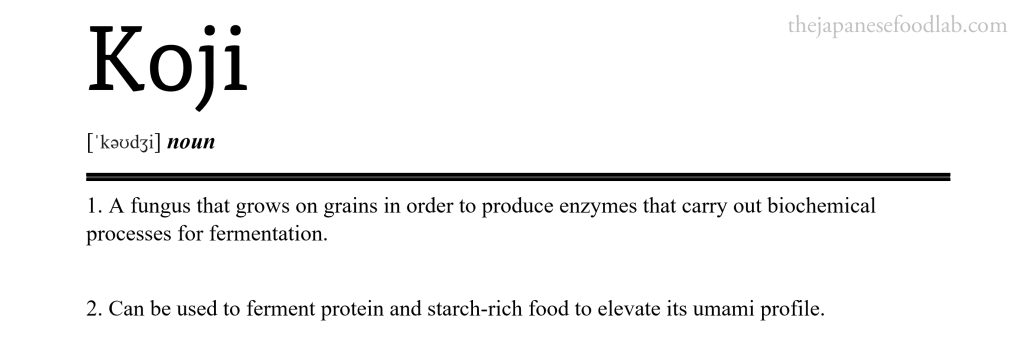
Is Koji a fungus?
While we don’t think about them explicitly, we encounter fungi everywhere in our lives. Whether it’s our bread growing mold or the mushrooms we see growing on a field after a rainy day. Out of sight, they play an extremely important role in our ecosystem as decomposers. Have you ever wondered where all the dead plant matter such as leaves or branches in a forest disappear to? Or what happens to the bodies of wild animals and their excrement? Alongside the many detritivores such as beetles, flies and earthworms, a myriad of different fungi slowly colonize and assimilate the organic matter in the environment, breaking it down and recycling them into nutrients that can then be reused by living things to grow again. It’s not an understatement to say that fungi are earth’s natural stomach.
Organisms part of the fungus kingdom come in many forms. For instance, the yeast we use to brew beer, ferment wine and bake bread, is an example of a single-celled (unicellular) fungus. The majority of fungi however, grow using filaments called hyphae. An easy way to imagine hyphae is to think of a plant’s roots. The hyphae grows all over and into its food source, just like how a plant’s roots grow deep into the soil in search of nutrients. This however, is where the analogy starts to differ. Instead of simply absorbing the readily available nutrients and water like a plant’s roots, the hyphae instead secrete proteins known as enzymes which digests the matter around them before absorbing it.
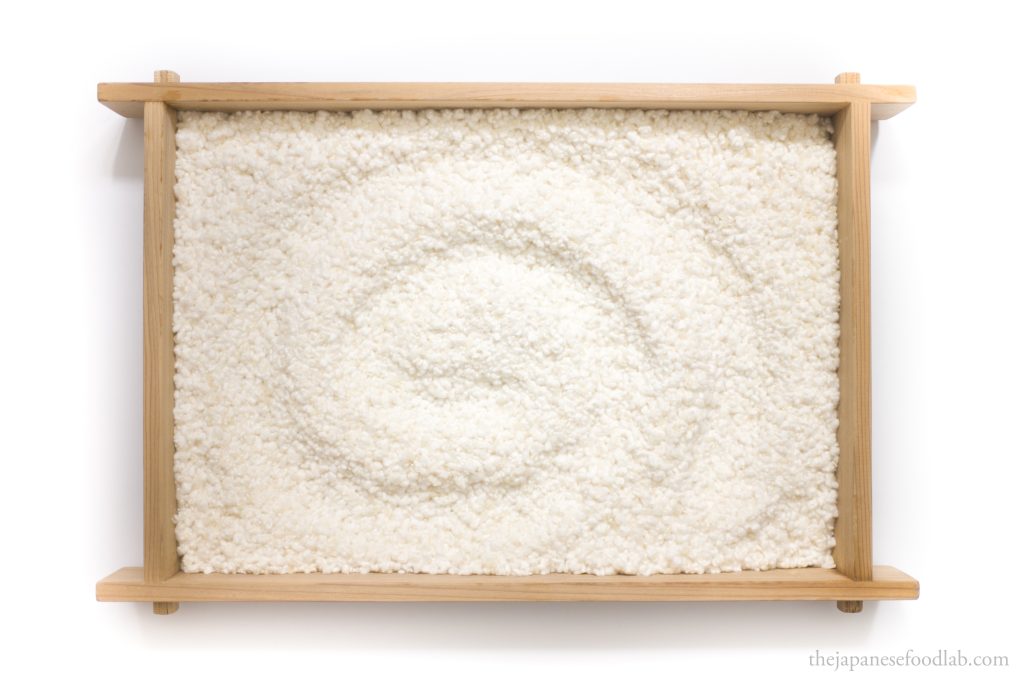
Extracellular digestion in fermented food
All living things on earth produce and use enzymes to carry out the life-sustaining processes. It is the slight difference in how the enzymes are used which are what makes fungi so special. To fully appreciate things, think about us humans. In order to obtain nutrients, we first consume our food, internalizing it in our stomach where enzymes secreted by our pancreas begin the process of digestion. This is known as intracellular digestion. In contrast, fungi secrete their enzymes into the environment, thus having the process of digestion occur outside the body before the absorption of nutrients occurs. This is known as extracellular digestion.
Whilst not the most pleasant analogy, imagine if we humans vomited out our stomach juices onto our food and let the food digest on the plate first, then only consuming the food. That’s how extracellular digestion works.
The key aspect of extracellular digestion that makes it so useful is that enzymes produced by the koji to digest the food never stop working. As enzymes are proteins and non-living biological molecules, they will continue to break down nutrients in the environment even if the fungus that produced them has been killed or is not able to absorb all the nutrients in time. Instead, some nutrients are left behind in the environment for other animals or plants to make use of or consume themselves. By taking advantage of this unique characteristic, we have created many of the delicious foods we know today. For example, when making barley miso, we add barley koji to soybeans because we’re making use of the enzymes produced by the koji to breakdown the proteins and starches in the soybeans, transforming it into a delicious savory paste.
As part of the fungus kingdom, Koji (Aspergillus oryzae) works in exactly the same way, growing hyphae into the grains of our choice, all the way secreting enzymes to extracellularly digest the nutrients in the grain and magically transforming it’s taste.
The life cycle of koji
In Japan, koji has predominantly been grown on rice, barley or soybeans in order to make sake, miso and soy sauce. Its ability to digest starch and proteins makes it suitable to grow on a variety of different grains, beans or substrates of your choice. You can read more in our article on the science of koji.
But when we say that we grow koji on grain, what exactly does that mean? That’s probably best exemplified through its entire life-cycle from spore all the way to sporulation.
*All the images in this section of the article were created using a hitachi electron microscope.
The beginning of the koji life cycle, or any fungus life cycle, begins with spores. Spores work similarly to the seeds of plants, with the main difference being that they’re unicellular and do not carry nutrients with them. To obtain koji spores, your best bet is to find a seller online which most likely have sourced their spores from one of the few specialist companies in Japan that culture and sell koji spores (moyashi-ya/もやし屋). Catching your own wild koji spores from the air as you would yeast for sourdough is extremely rare due to the much more complicated environmental conditions needed for you to succeed.
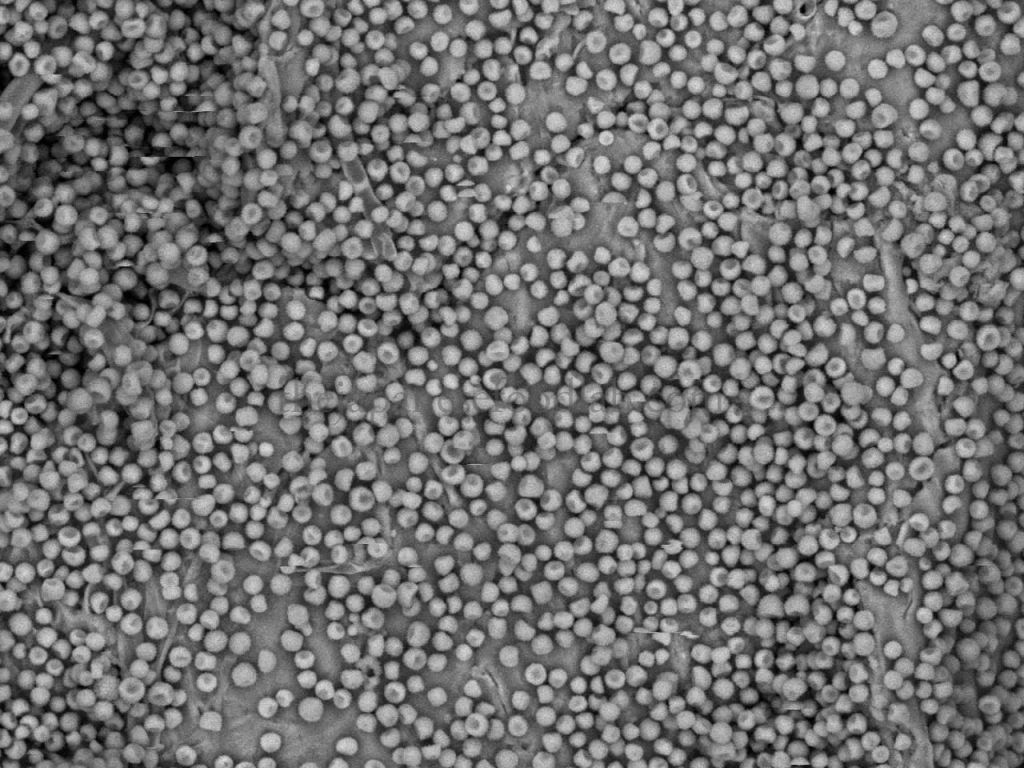
Spores brought from manufacturers tend to come in two forms, either powdered spores or dried grains covered with spores. Either one works as well as the other, but we personally have found powdered spores easier to work with.
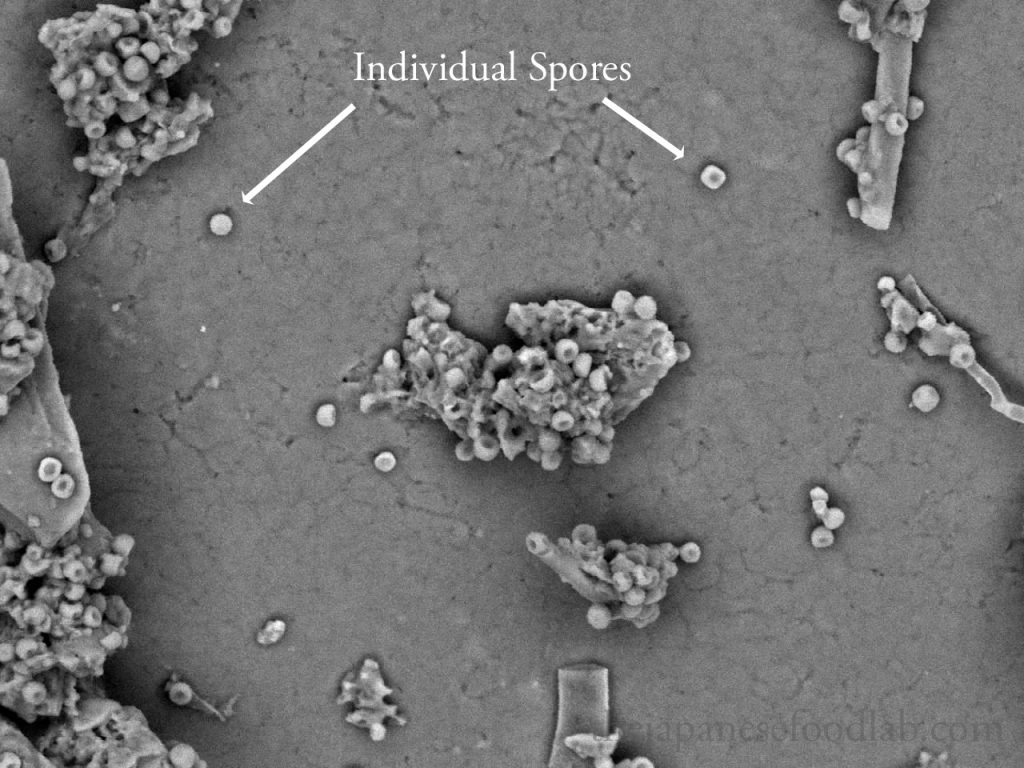
When zoomed into, the spores appear as hard-shelled spheres with a small indentation. To begin, we inoculate our grain of choice with koji by sprinkling then mixing our grains together with the spores, trying to ensure that the surface of every grain of rice has at least one spore on it.

Under the optimal temperature, humidity and nutrition from the grains, the spores germinate and start to grow their hyphae. The hyphae grow rapidly across the surface of the grain, but also penetrate into the grain in order to obtain as much nutrition as possible. 12 hours after inoculation, we can start to see the growth of hyphae beginning to occur across the grain of rice under an electron microscope.
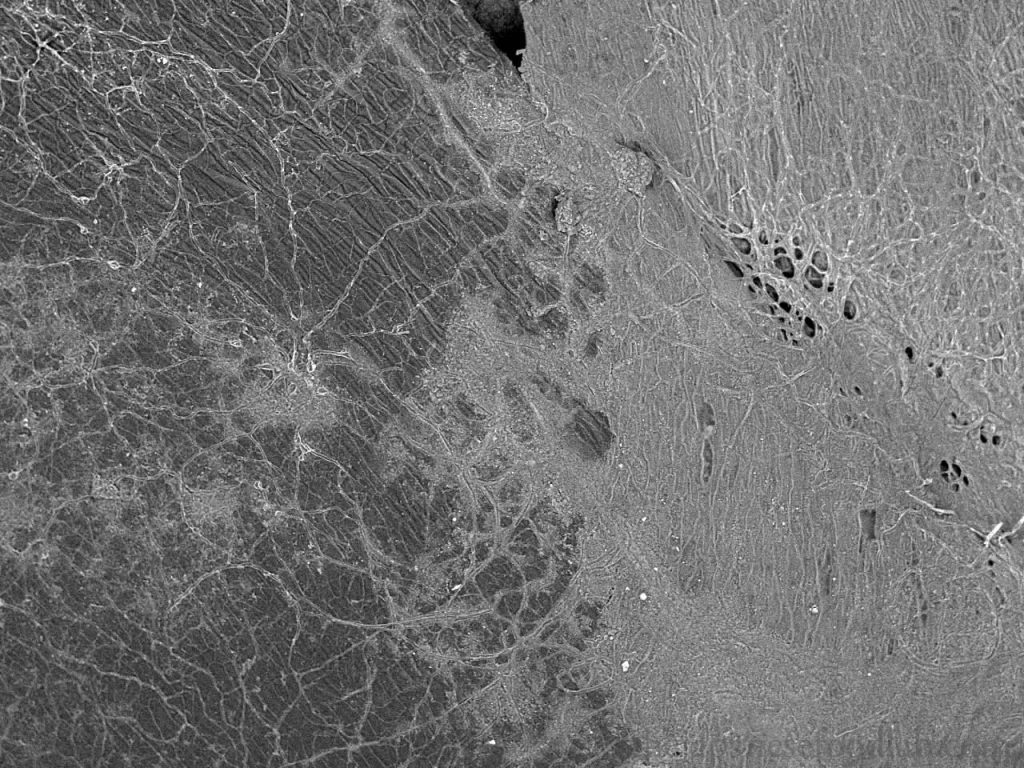
After 24 hours, the hyphae have almost grown across the entire surface area of the grain, albeit in a thin layer.
If the conditions are right and you have a particularly vigorous batch of koji, it’s sometimes possible to see wisps of white on the grains with the naked eye at this stage. During this time, the rate of hyphae growth is at its peak.
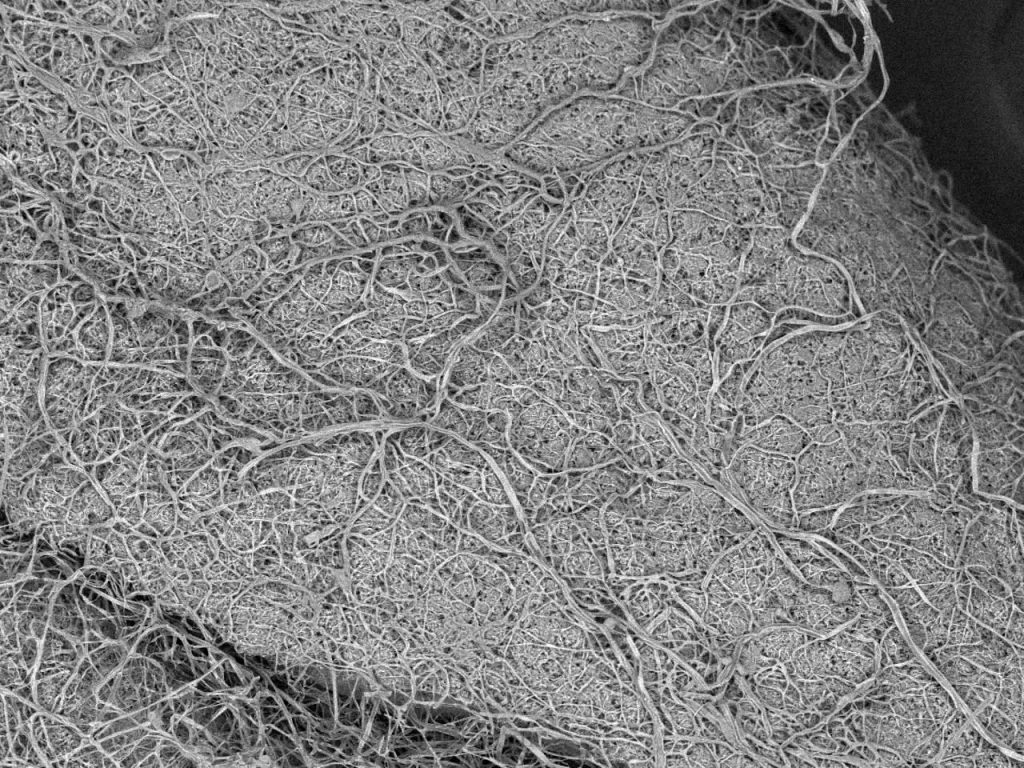
As the hyphae grow over and penetrate into the grain, they secrete enzymes into their environment, breaking down the nutrients in the grains so that it can be easily absorbed into the hyphae, fueling its continual growth as it colonizes the entire bed of grain. As the hyphae grow, so does the rate of extracellular digestion, in turn further accelerating the growth of hyphae exponentially. After 36 hours, the entire grain of rice has been completely encapsulated by hyphae.
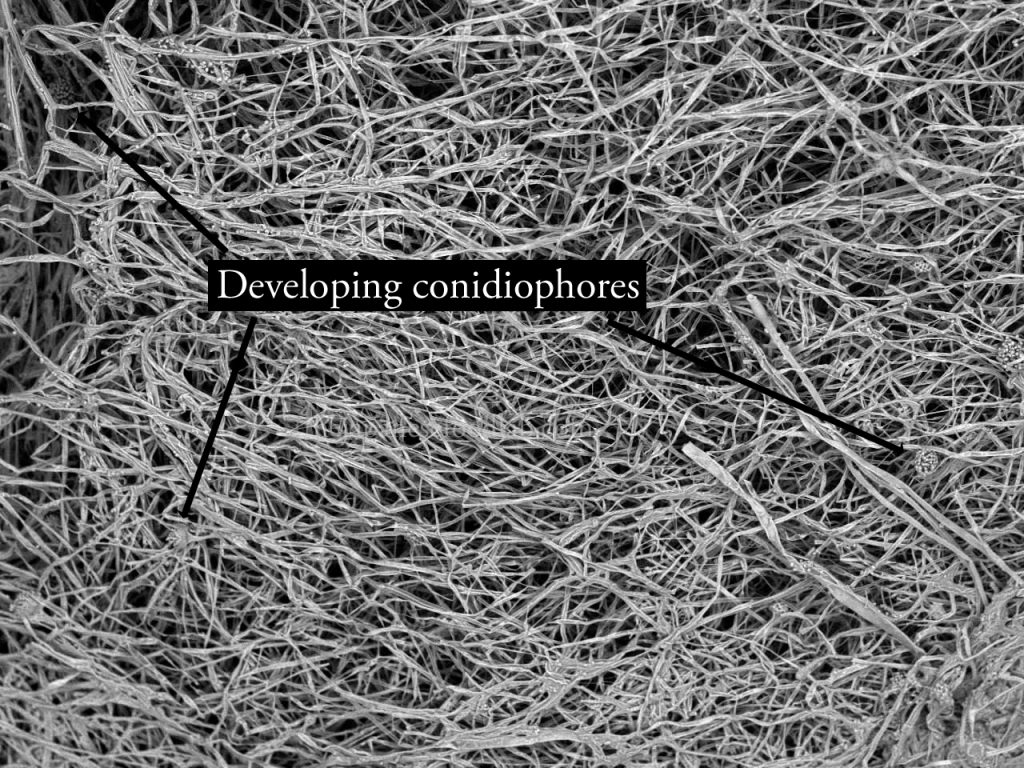
At the 48 hour mark, so much hyphae has covered the surface of the grains so thickly that it’s no longer possible to see the surface area of the grain. This mass of hyphae are what makes up the body of koji (or any other hyphae producing fungus) and is known as a mycelium. At this point, the rate of enzyme production is at its peak and therefore is the best time for us to harvest and use our koji.
Before this, the nutrients absorbed by the koji were mainly invested into the production of enzymes and the growth of hyphae. Past this time, the nutrients absorbed and energy produced start being redirected into the production of spores.
The reproductive organs of koji are known as conidiophores which look and function similarly to a dandelion. The spores grow all over the tips of the conidiophore and once mature, are released to propagate the next generation, thus beginning the life cycle again.
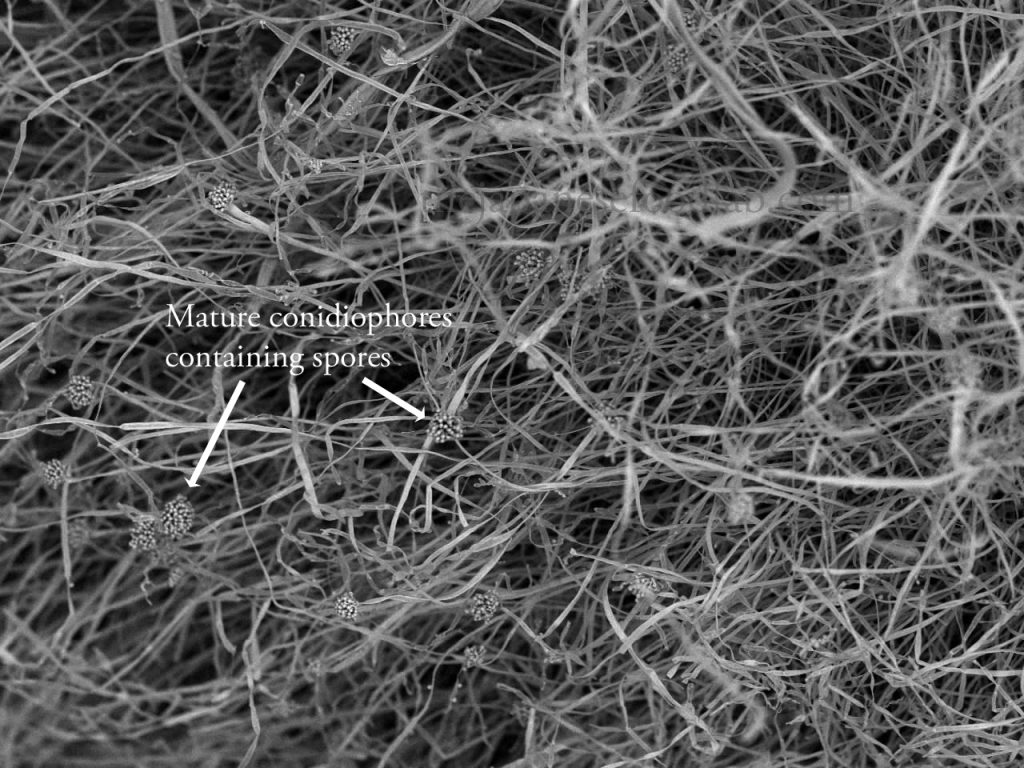
When looking at images of koji under an electron microscope, you can see the beginning stages of what will be conidiophores growing at around the 48 hour mark. At this point the spores are still in their infancy and cannot be used to propagate koji. They will continue to mature up until hour 84, or around three and a half days of growing, after which they can be dried, stored and used to inoculate another batch of koji.
The types of Koji enzymes
So what exactly are enzymes? As a general definition, enzymes are biological molecules that speed up the rate of chemical reactions. For our context specifically, enzymes are proteins that help breakdown nutrients into smaller and more easily absorbed molecules.
Enzymes are made by all living things and can be found everywhere you look. To make things easier to understand, scientists named enzymes using a system. If the word ends with the -ase suffix then we know it’s an enzyme. The prefix of the word therefore describes the substance it works on. For example, the enzyme lactase is added to milk to break down lactose into galactose and glucose to make lactose free milk. As you can see from the name of the enzyme, the prefix ‘lact’ denotes that it works on lactose and the suffix ‘-ase’ denotes that it’s an enzyme.
Koji is useful to us because it produces a whole host of enzymes that are useful to us not only in the fermentation world, but even the commercial and pharmaceutical industry. Of the many enzymes that koji produces, there are three main groups of enzymes that we are mainly interested in as fermenters: amylases, proteases and lipases.
Read our article on the science of koji enzymes to learn more about proteins and enzymes.
Amylase
To learn about amylases, we first have to learn about sugars and starch. There are many different molecules that we call sugar colloquially such as glucose, galactose and sucrose etc, all which taste sweet to the human tongue. Biochemically, another word for sugar is saccharide, therefore one individual molecule of sugar such as a glucose or sucrose is known as a monosaccharide (mono- meaning only one).
Starch actually consists of long chains of individual sugar molecules linked together and is therefore known as a polysaccharide (poly- meaning many). Importantly, when linked together to form a polysaccharide, they no longer taste sweet. That’s why pasta and rice, which consist mainly of starch, do not taste sweet.
Amylases are enzymes that break down polysaccharides into smaller and smaller segments of saccharides. Koji produces different types of amylases which break down different types of polysaccharides into shorter segments alongside other enzymes that further breakdown these short segments of saccharides into monosaccharides. This is why when you taste rice koji it should taste slightly sweet, because the koji has secreted amylases onto the rice, breaking down the starch in the rice into simple sugars. The enzyme that breaks down the starch in the food we eat is also a type of amylase and can be found in our saliva and stomach juices.
Proteases
Proteases are the protein equivalent of amylase. Proteins are actually made from long chains of amino acids folded together. Making a wide generalization, there exist 20 amino acids that in different permutations of 50 to 2000 amino acids chains long, make up the vast majority of proteins we know. Arguably the most famous of the amino acids are glutamic acid and inosinic acid as they are the source of our perception of a food’s deliciousness and savoriness that we have come to know as umami.
The various different proteases are able to break apart the bonds between different amino acids in a protein chain, breaking up the protein into smaller segments and then into their constituent amino acids. As the proteases continue to work, the taste of substrate the koji is added to becomes more and more umami rich.
Lipases
Lipases are the enzymes that break down fat into fatty acids and alcohol. While we’ve spent most of this article talking about the wonders for koji’s transformation powers through enzymes, lipase is probably one of the areas where koji falls short. Among the vast array of enzymes produced by koji, koji only produces a tiny amount of lipase and thus does not do well breaking down substrates which contain a high amount of fats. This includes vegetable fats as well such as nuts and seeds. This is why there are no examples of traditional Japanese ferments using koji which involve substrates that have a high fat content. Soybeans for miso, wheat for soy sauce and rice for sake all have a very low fat content. When we look at katsuobushi, which is made from bonito fish high in protein and fat, they’re fermented using a different species of fungus, Aspergillus glaucus which is much more adept at breaking down fat.
If you were to search and read about a lot of modern day ferments using koji in the western world, many are done with substrates high in fat such as cocoa bean miso or various nut misos. These ferments have a danger of going rancid if left to age for a long time. Most resources will tell you to age them for a few weeks up to around a month and at a lower temperature to prevent this, but I personally feel this defeats the purpose as it doesn’t provide enough time for complex tastes to develop.
Koji and hydrolysis
Often overlooked in resources that talk about koji is the fact that all the biochemical processes discussed above are examples of enzymatic hydrolysis. This means that enzymes are only able to break down the starches, proteins and fats in the presence of water through a process known as hydrolysis. This is important because it explains the importance of the water content of our ferments and is one of the reasons why misos that are too dry tend not to ferment well.
You’ll sometimes come across the term autolysis used to describe koji’s enzymatic processes. This is inaccurate as autolysis refers to the biochemical activity of enzymes inside the koji cells itself when, as mentioned above, the enzymes are secreted out of the hyphae to carry out extracellular digestion. Even when the koji is no longer alive, the enzymes will still continue to hydrolyse proteins, starches and fats.
How does koji create umami?
Umami is a term used to describe the savory taste of certain foods. It is one of the five basic tastes, along with sweet, sour, bitter, and salty. The flavor of umami is often described as rich, meaty or savory, and is commonly found in certain types of meats, cheeses, and vegetables. The main reason behind koji’s amazing ability to transform any food or substrate it’s added to is because it greatly increases the umami of the substrate whilst also enhancing its flavor and aroma profile.
When the enzymes produced by koji start working on a substrate by breaking the bonds between the long chains of starches and amino acids, the resulting smaller fragments or molecules all differ in length. It is the vast variety of different molecules that register as different tastes and smells on our receptors.
Furthermore, as proteins are broken down into amino acids, some of the amino acids produced are glutamic acid and inosinic acid, which are responsible for the umami flavor of many natural foods such as mushrooms, cheese and tomatoes. As the concentration of these amino acids increases, so does our perception of the umami. This is why simple soybeans can taste like a rich meaty paste when made into miso.
I enjoyed reading this information about Koji Spores.
I was wondering what benefits the koji ENZYMES do when consumed by humans. Is it only for the added flavor to satisfy our palate? Or are their other benefits to eating this fungus?
I bought Miso soup paste to make at home and realized that the only nutritional facts list stated it has 1 gram protein, 25 mg of potassium,310mg of sodium,3g carbs,1g of fiber and 2g of sugar. How is this at all going to satisfy the recommended DV%. This nutritional data is for 2 tsp. I’d have to eat so much of the stuff to be satisfied. It’s good taste with black pepper and some other spices 🥷
Koji enzymes are not basically eaten as they are and are mainly used for preparation of fermented products. Koji-based foods (like miso, amazake, šiokódži, and others) are basically “only” condiments and not meant to be eaten as main and bulk dish.
And, eating enzymes as they are is not advatageous – enzymes would be destroyed by stomach acid very quickly.
Hi David, these enzymes are similar to what our body makes for the process of digestion. For example: Amylase is primarily found in the mouth to digest carbohydrates (various forms of sugars in our foods), which is one reason why it is so important to chew our food well. Protease helps digest proteins in our foods, and lipase – fats. In our stomach and gut these allow (as mentioned above) our food to be broken down to amino acids, which are the building blocks of much of our cells and of every protein made by our bodies which also direct processes. When we eat fermented foods such as these, it helps to improve digestion, but that’s not all. Our personal microbiome (our gut bacteria) are a very delicate balance of many microbes. Science has found that this heavily impacts our immunity and has come to be known as the “second brain” of the body because the gut bacteria doesnt just digest, it fights invaders alomg side our immune cells, and also helps send signals to our brains about a variety of internal activity that impacts our health. This has become so well documented that when these “good bacteria” are killled off by stress, poor diet, antibiotics or otherwise, opportunistic pathogens grow out of control and make us sick, to the point that science is trying to document microbiome patterns associated with chronic diseases. Therefore, these are not only helpful in digestion but essential to good health. Hope this helps!